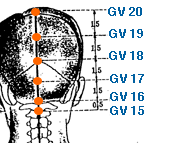GV 20
Acupuncture Point Theory
GV 20 Acupuncture Point Applications and Theory
 The acupuncture point "GV 20" , 百會, is represented by "Bai Hui" in pinyin and "Hundred Convergences" in english and may be found:
The acupuncture point "GV 20" , 百會, is represented by "Bai Hui" in pinyin and "Hundred Convergences" in english and may be found:
5 cun posterior to the AHL.
Of many possible clinical applications, it may be considered to influence the following issues/symptoms:
- Main point for headache, dizziness, eye pain and redness, irritability, hypertension from excess yang in the upper body, often occuring with patterns of excess Liver yang or Liver fire. Combine with lower body points such as LV 2, LV 3, KD 1, GB 34, GB 41.
- Main point for internal wind which has some overlapping indications with the above entry, for headaches, dizziness, visual dizziness, tinnitus, vertex pain, windstroke, seizures.
- Main point for prolapse, anal, uterine, vaginal; main point for hemorrhoids.
- Tong Ren/Tam Healing System: Used to effect the association area (related to emotions, memory, behavior), useful for low energy, yang energy imbalances, parkinson's, alzheimer's, motor control issues.
Gv 20 has the following theoretical associations which serve as important guideposts in designing an effective treatment protocol:
- Sea of Marrow Point (with GV 16)
- Intersecting Point of the Governing Vessel, Urinary Bladder, Gall Bladder, Triple Heater & Liver Channels
Explore gv 20 functional grouping theory - Four Seas, or read all point categories and related theory.
While not necessarily valid clinically, UB 8 (Resolve phlegm and clear wind - nasal congestion,…) are nearby.
All Content 1999-2025
Chad J. Dupuis / Yin Yang House
Our Policies and Privacy Guidelines
Our Affiliated Clinics
